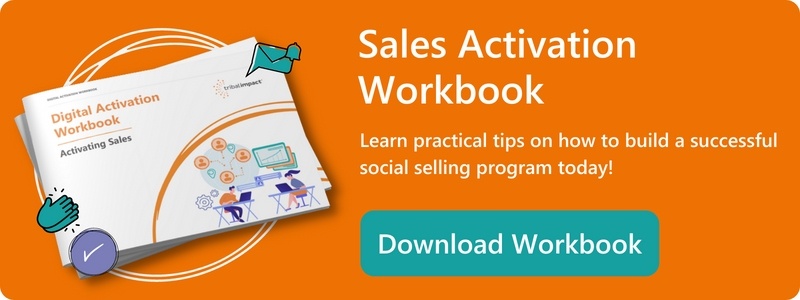Social selling is “a really great way to connect with prospects in a more personalised and authentic way,” according to our recent interviewee, Sandy Adam.
Sandy is the Global Sales Enablement Senior Manager at Quest Software. Her first role in the industry was Director of Social Media for a software company. There, she started introducing the concepts to her colleagues and explaining why subject matter experts should try to build their relationships with customers on social.
In our interview, Tribal Impact’s Sarah Goodall spoke to her about the role of change management in social selling, how to roll out a social selling program, and demonstrate its ROI.
Read on for our recap or check out the full interview on our podcast or LinkedIn.
What is social selling?
For Sandy, social selling is using social media platforms and networks to engage customers. It’s not about building relationships to go out for coffee with someone, it’s knowing the right people and having the right conversations.
The average number of stakeholders contributing to a purchase decision is now 11.4, up from an average of 6.8 people in 2016! (Source).
And LinkedIn data found that 86% of sales reps have lost a deal or had it delayed because someone left or moved within the target company.
Its data also found that top-performing reps were more likely to have multiple connections with a business.
So just knowing one or two people isn’t enough anymore. As Sandy put it, "someone could go dark at any moment." Which puts you back at the beginning of the sales process.
Who to select for your social selling program
Sandy suggested finding people who seem like they’re more open to trying something new and mentoring them. Focus on those 4-5 people, then show their successes. Then you’ve built the case studies of the program’s success to show other teams.
The successes she shares include booking meetings and more quantifiable data.
She collects messages from employees who share their success stories with her and uses them in presentations.
How do you enable the masses?
Sandy focuses on integrating social selling into existing sales processes, rather than asking if salespeople can do more on top of their existing activities.
She also runs quarterly classes on how to use LinkedIn and lessons on social selling are built into the employee onboarding program.
There’s a one-hour session for them that introduces the concept, talking about the reasons behind it, how to optimise their profile, and sharing that she’s open to one-to-one calls.
She doesn’t get loads of interest in the one-to-one calls. It’s not about scaling that part.
It’s about scaling the activities of people who are interested – giving a personal touch and building trust in her ability to give them the right advice. This makes those people more likely to follow subsequent advice, too.
How is AI impacting social selling?
Sandy suggested posting content about AI to get more attention and help people understand it since everyone is curious about it anyway.
During the sales process, salespeople will inevitably run into questions about AI and how it’s built into the product too.
AI is already built into company laptops that use Microsoft, with its new Co-Pilot. So it’s hard to pretend it doesn’t exist. Businesses need to prepare their workforce for what’s coming.
However, Sarah emphasised the importance of educating employees on using generative AI for content creation so that they understand what they can/can’t do with it.
Currently, salespeople spend just 23% of their time actually selling according to data from Forrester. AI could help sales teams be more efficient, as data suggests that by 2028, 60% of sales will be done by generative AI. (Source: Gartner).
Meeting sales quotas with social selling
Sarah shared the stat that businesses which prioritise social selling are 51% more likely to reach their sales quotas according to LinkedIn.
When it comes to ROI, if you’ve got it synced to a CRM, Microsoft can show you how much revenue LinkedIn Sales Navigator has influenced. It’s hard to deny when you see the stats.
Sandy does a quarterly business review where she shares the results of the program and doesn’t get many questions from the data – it speaks for itself.
Social selling creates more authentic connections
Social selling should be an important part of any modern business’s sales process. It builds employees’ brands and creates deeper connections with prospects, meaning that they’re more likely to think of the business when it’s time to buy.
If you’d like help building or scaling your social selling program, Tribal Impact can help.


